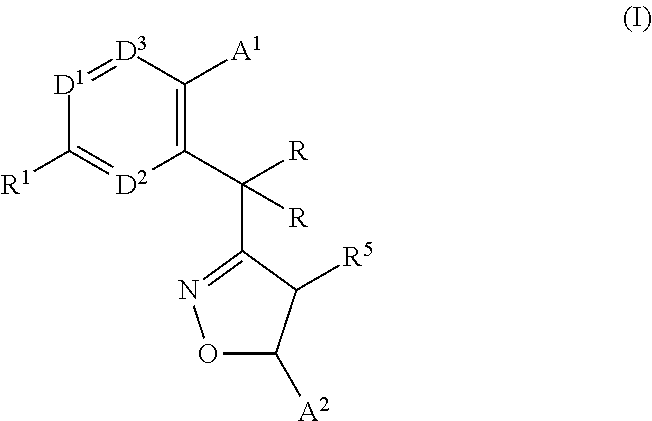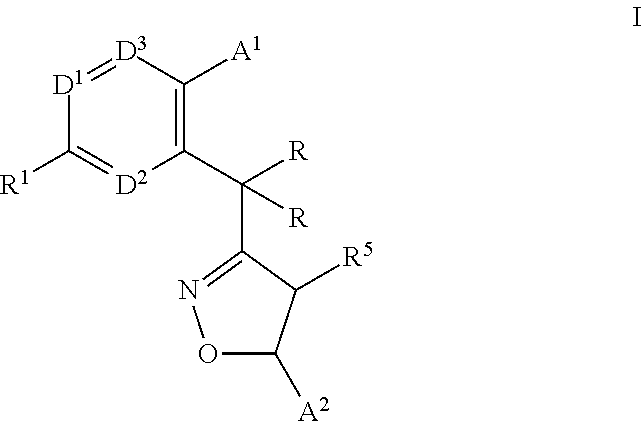Monocyclic isoxazolines as inhibitors of cholesterol ester transfer protein
a technology of ester transfer protein and monocyclic isoxazoline, which is applied in the direction of heterocyclic compound active ingredients, drug compositions, cardiovascular disorders, etc., can solve the problems of chd risk, high risk of chd, and low serum hdl-c level, and achieve the effect of only achieving a risk reduction of approximately one-third
- Summary
- Abstract
- Description
- Claims
- Application Information
AI Technical Summary
Benefits of technology
Problems solved by technology
Method used
Image
Examples
example 1a and 1b
[0247]
[0248](S)-2″-((5-(3,5-bis(trifluoromethyl)phenyl)-4,5-dihydroisoxazol-3-yl)methyl)-6′-fluoro-4′-methoxy-2-methyl-4″-(trifluoromethyl)-[1,1′:3′,1″-terphenyl]-4-carboxylic acid 1A and (R)-2″-((5-(3,5-bis(trifluoromethyl)phenyl)-4,5-dihydroisoxazol-3-yl)methyl)-6′-fluoro-4′-methoxy-2-methyl-4″-(trifluoromethyl)-[1,1′:3′,1″-terphenyl]-4-carboxylic acid 1B
[0249]Step 1:
[0250]To a 5 mL microwave tube were added Cs2CO3 (75 mg, 0.23 mmol), PdCl2(dppf)-CH2Cl2 adduct (12 mg, 0.015 mmol), 5-(3,5-bis(trifluoromethyl)phenyl)-3-(2-bromo-5-(trifluoromethyl)benzyl)-4,5-dihydroisoxazole (40 mg, 0.077 mmol) and (6-fluoro-4-methoxy-4′-(methoxycarbonyl)-[1,1′-biphenyl]-3-yl) boronic acid (46 mg, 0.115 mmol), followed by 1,4-dioxane (6 mL). The mixture was stirred at 110° C. for 3 hours. After cooling, it was diluted with EtOAc and then was washed with water. The organic layer was concentrated and purified on Gilson HPLC with a reverse phase column to yield methyl 2″-((5-(3,5-bis(trifluoromethyl)ph...
example 2
[0253]
(S)-5-(2″-((5-(3,5-bis(trifluoromethyl)phenyl)-4,5-dihydroisoxazol-3-yl)methyl)-6′-fluoro-4′-methoxy-2-methyl-4″-(trifluoromethyl)-[1,1′:3′,1″-terphenyl]-4-yl)-1,3,4-oxadiazol-2(3H)-one
[0254]Step 1:
[0255]To a 50 mL RBF were added (S)-2″-((5-(3,5-bis(trifluoromethyl)phenyl)-4,5-dihydroisoxazol-3-yl)methyl)-6′-fluoro-4′-methoxy-2-methyl-4″-(trifluoromethyl)-[1,1′:3′,1″-terphenyl]-4-carboxylic acid (150 mg, 0.214 mmol), PyBOP(167 mg, 0.322 mmol), DIEA (150 uL, 0.858 mmol), and hydrazine hydrate (16 mg, 0.322 mmol), followed by DMF (2 ml). The mixture was stirred at RT for 2 hours, diluted with EtOAc and washed with water. The organic layer was dried with Na2SO4, filtered, and concentrated. The crude product was used for the next step without further purification. MS ESI calc'd. for [M+H]+ 714.5, found 714.4.
[0256]Step 2:
[0257]To a 5 mL vial were added (S)-2″-((5-(3,5-bis(trifluoromethyl)phenyl)-4,5-dihydroisoxazol-3-yl)methyl)-6′-fluoro-4′-methoxy-2-methyl-4″-(trifluoromethyl)-[1...
example 3a and 3b
[0258]
[0259]2″-(((4S,5R)-5-(3,5-bis(trifluoromethyl)phenyl)-4-methyl-4,5-dihydroisoxazol-3-yl)methyl)-4′-methoxy-2-methyl-4″-(trifluoromethyl)-[1,1′:3′,1″-terphenyl]-4-carboxylic acid 3A and 2″-(((4R,5S)-5-(3,5-bis(trifluoromethyl)phenyl)-4-methyl-4,5-dihydroisoxazol-3-yl)methyl)-4′-methoxy-2-methyl-4″-(trifluoromethyl)-[1,1′:3′,1″-terphenyl]-4-carboxylic acid 3B.
[0260]Step 1:
[0261]To 5-(3,5-bis(trifluoromethyl)phenyl)-3-(2-chloro-5-(trifluoromethyl)benzyl)-4-methyl-4,5-dihydroisoxazole B1 (0.14 g, 0.20 mmol) was added THF (2.0 mL), water (0.5 mL), tribasic potassium phosphate (0.18 g, 0.87 mmol), (4′-(tert-butoxycarbonyl)-4-methoxy-2′-methyl-[1,1′-biphenyl]-3-yl)boronic acid (0.197 g, 0.37 mmol) and chloro(2-dicyclohexylphosphino-2′,4′,6′-triisopropyl-1,1′-biphenyl)[2-(2-aminoethyl)phenyl]palladium(II) (0.007 g, 0.01 mmol). The system was flushed with nitrogen gas and was heated at 60° C. overnight. The reaction mixture was diluted with ethyl acetate:hexanes (1:2, 10 mL) and was pa...
PUM
| Property | Measurement | Unit |
|---|---|---|
| Structure | aaaaa | aaaaa |
Abstract
Description
Claims
Application Information
 Login to View More
Login to View More - R&D
- Intellectual Property
- Life Sciences
- Materials
- Tech Scout
- Unparalleled Data Quality
- Higher Quality Content
- 60% Fewer Hallucinations
Browse by: Latest US Patents, China's latest patents, Technical Efficacy Thesaurus, Application Domain, Technology Topic, Popular Technical Reports.
© 2025 PatSnap. All rights reserved.Legal|Privacy policy|Modern Slavery Act Transparency Statement|Sitemap|About US| Contact US: help@patsnap.com



